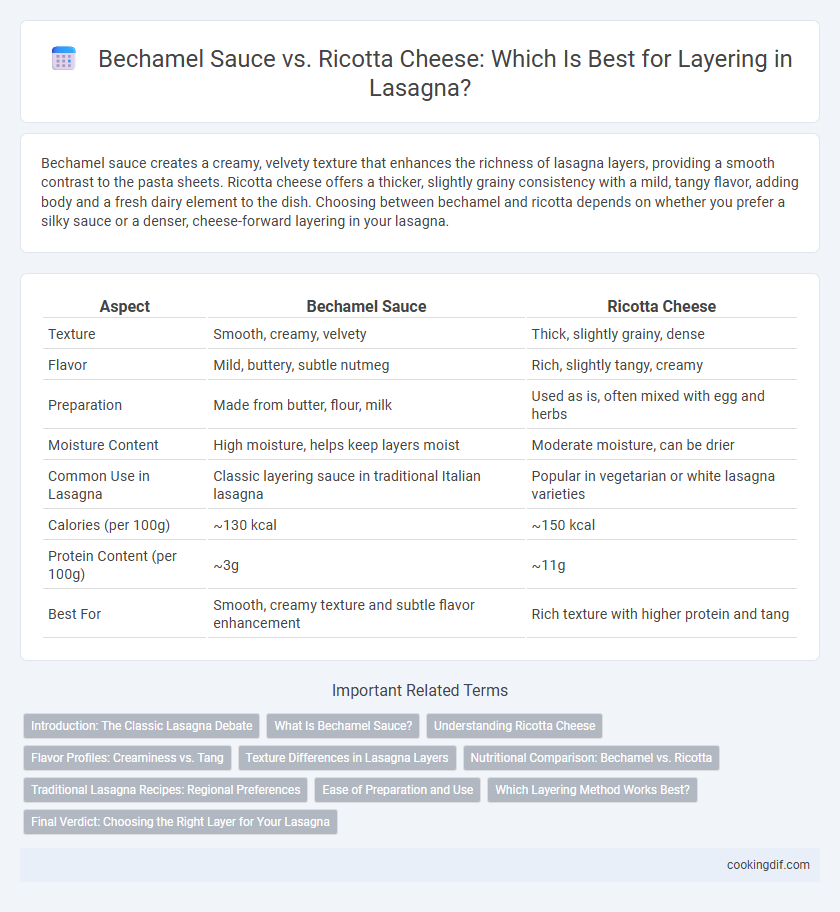Bechamel sauce creates a creamy, velvety texture that enhances the richness of lasagna layers, providing a smooth contrast to the pasta sheets. Ricotta cheese offers a thicker, slightly grainy consistency with a mild, tangy flavor, adding body and a fresh dairy element to the dish. Choosing between bechamel and ricotta depends on whether you prefer a silky sauce or a denser, cheese-forward layering in your lasagna.
Table of Comparison
| Aspect | Bechamel Sauce | Ricotta Cheese |
|---|---|---|
| Texture | Smooth, creamy, velvety | Thick, slightly grainy, dense |
| Flavor | Mild, buttery, subtle nutmeg | Rich, slightly tangy, creamy |
| Preparation | Made from butter, flour, milk | Used as is, often mixed with egg and herbs |
| Moisture Content | High moisture, helps keep layers moist | Moderate moisture, can be drier |
| Common Use in Lasagna | Classic layering sauce in traditional Italian lasagna | Popular in vegetarian or white lasagna varieties |
| Calories (per 100g) | ~130 kcal | ~150 kcal |
| Protein Content (per 100g) | ~3g | ~11g |
| Best For | Smooth, creamy texture and subtle flavor enhancement | Rich texture with higher protein and tang |
Introduction: The Classic Lasagna Debate
Bechamel sauce and ricotta cheese serve distinct roles in classic lasagna layering, each influencing texture and flavor. Bechamel sauce, a smooth, creamy white sauce made from butter, flour, and milk, adds a velvety richness and subtle taste that balances robust tomato and meat layers. Ricotta cheese, traditionally used in Italian lasagna, provides a thicker, creamier texture with a tangy flavor, creating a hearty and satisfying mouthfeel within each bite.
What Is Bechamel Sauce?
Bechamel sauce, a classic French white sauce made from butter, flour, and milk, provides a smooth, creamy texture and rich flavor that enhances lasagna layers without overpowering other ingredients. Its velvety consistency contrasts with Ricotta cheese, which adds a denser, grainier texture and a mild, slightly tangy taste. Chefs often choose Bechamel in traditional Italian lasagna recipes to create a silky, cohesive sauce layer that melds perfectly with pasta sheets and meat or vegetable fillings.
Understanding Ricotta Cheese
Ricotta cheese, a traditional Italian dairy product made from whey, offers a rich, creamy texture that enhances lasagna layers with a mild, slightly sweet flavor and high moisture content, which helps maintain the dish's softness. Unlike bechamel sauce, which is a smooth, flour-thickened milk-based sauce, ricotta adds a distinct, grainy consistency and a richer protein profile, contributing to the lasagna's nutritional value and mouthfeel. Its ability to blend well with herbs, eggs, and parmesan makes ricotta a versatile, flavorful choice for layering that complements the pasta and tomato sauce in classic lasagna recipes.
Flavor Profiles: Creaminess vs. Tang
Bechamel sauce offers a rich, velvety creaminess that enhances lasagna layers with a smooth, buttery texture and mild flavor, creating a luxurious mouthfeel. Ricotta cheese provides a slightly tangy, fresh taste with a grainier texture, adding brightness and a subtle acidity that balances the richness of meat and tomato sauces. Choosing between bechamel and ricotta depends on whether the desired flavor profile emphasizes silky indulgence or lively tanginess in the lasagna's composition.
Texture Differences in Lasagna Layers
Bechamel sauce creates a smooth, creamy texture in lasagna layers that melds ingredients together seamlessly, providing a rich, velvety mouthfeel. Ricotta cheese offers a thicker, slightly grainy texture that adds distinct layers and a more substantial bite. The choice between bechamel and ricotta significantly affects the overall mouthfeel and structural integrity of the lasagna.
Nutritional Comparison: Bechamel vs. Ricotta
Bechamel sauce typically contains higher calories and saturated fats due to butter and whole milk, providing a creamy texture but increased fat content. Ricotta cheese offers more protein and calcium with lower saturated fat, making it a nutrient-dense option for layering in lasagna. Choosing ricotta supports a higher protein intake and better micronutrient profile, while bechamel enhances richness but with more calories.
Traditional Lasagna Recipes: Regional Preferences
Traditional lasagna recipes in Northern Italy typically favor bechamel sauce for its creamy texture and subtle flavor, enhancing layers without overpowering other ingredients. In contrast, Southern Italian lasagna often incorporates ricotta cheese, providing a richer, tangier taste that complements robust tomato sauces and meat fillings. Regional preferences highlight the diverse culinary heritage, with bechamel commonly used in Emilia-Romagna and ricotta favored in Campania and Sicily.
Ease of Preparation and Use
Bechamel sauce offers a smooth, creamy texture that spreads easily and integrates well with other ingredients, making it ideal for uniform layering in lasagna. Ricotta cheese requires minimal preparation but can be crumbly and uneven, often needing to be mixed with eggs or seasoning for better consistency and flavor. Choosing bechamel simplifies assembly with its pourable consistency, while ricotta offers a quicker, less processed option at the expense of a less cohesive layer.
Which Layering Method Works Best?
Bechamel sauce creates a creamy, smooth texture that evenly distributes moisture throughout lasagna layers, enhancing the overall richness without overpowering other ingredients. Ricotta cheese adds a denser, slightly grainy texture with a mild tang, contributing to a more rustic and hearty mouthfeel. The best layering method depends on preference: bechamel achieves a silky, cohesive structure, while ricotta offers a thicker, more textured bite.
Final Verdict: Choosing the Right Layer for Your Lasagna
Bechamel sauce offers a creamy, smooth texture with a subtle buttery flavor that enhances the overall richness of lasagna, creating a cohesive and silky layering experience. Ricotta cheese provides a thicker, grainier texture with a tangy taste, adding hearty protein and a rustic authenticity to the dish. Choosing between Bechamel and Ricotta depends on whether you prefer a velvety consistency or a robust, textured bite in your lasagna layers.
Bechamel sauce vs Ricotta cheese for layering Infographic

 cookingdif.com
cookingdif.com